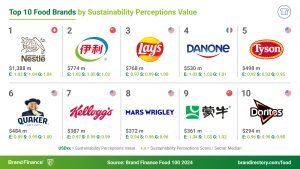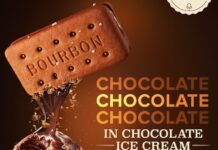
Nestlé, whose brand value is down 7% to US$ 20.8 billion, still continues to hold the title of the world’s most valuable food brand, while India’s Amul is the strongest food brand with an AAA+ rating, states the Brand Finance Food & Drink 2024.
Despite a decline in brand value, Nestlé’s strong brand equity and resilience have helped it maintain its top position in the global food industry. Nestlé’s ability to adapt to changing consumer preferences and maintain a diverse product portfolio has been instrumental in its continued success.
Amul, whose brand value is up 11% to US$3.3 billion, has risen to become the world’s strongest food brand, with a Brand Strength Index (BSI) score of 91.0 out of 100 and an AAA+ rating. Amul’s brand strength is attributed to its strong performance in familiarity, consideration, and recommendation metrics. Amul’s unique branding strategy, rooted in its cooperative structure and impactful marketing campaigns, has solidified its position as a household name in India. With an 85% share in the Indian butter market and 66% market share in cheese, Amul’s branding efforts have successfully resonated with consumers.
Lay’s, whose value is up 9% to US$12 billion, has climbed to the second position globally, surpassing Yili (brand value down 6% to US$11.6 billion), which holds the third spot. Lay’s strong financial performance and innovative product offerings, such as its Flavour Swap and MAX lineups, have contributed to its brand value growth.
The food and beverage sector has seen a 4% decline in brand value this year, totaling around USD268 billion. Consumers are increasingly favoring smaller, private label brands over big names for unique, personalized products.
Savio D’Souza, valuation director at Brand Finance, said, “The food and beverage industry is undergoing a rapid transformation driven by evolving consumer preferences. While the decline in brand value is a challenge, it also presents opportunities for innovation. Brands that successfully adapt to these trends by demonstrating strong brand purpose and delivering exceptional consumer experiences will be the ones to thrive in this new landscape.”

Convenience foods see rising brand value due to demand
Convenience foods and dairy remain as major contributors, with convenience foods thriving due to the busy lifestyles of consumers and dairy staying strong thanks to plant-based options and health trends. These shifts challenge established brands to adapt, while new brands capitalize on changing consumer preferences.
Leading brands in this segment include Healthy Choice and DiGiorno both of which have successfully adapted to changing consumer preferences through innovative product releases and strategic marketing.
Viterra is the fastest-growing food brand, with its brand value up 37%. With its brand value up 37% to US$.1 billion, Viterra has recorded the largest brand value growth by percentage in the ranking. This growth is supported by increased volumes, strategic acquisitions, and a higher BSI score, now at 60.6 out of 100.
Coca-Cola and Pepsi lead non-alcoholic drinks market
Coca-Cola, whose brand value up is 5% to US$35 billion, retains its title as the world’s most valuable non-alcoholic drinks brand.
Carbonated soft drinks dominated the top 10, with Pepsi, Dr Pepper, and Sprite leading the way. Four of the top 10 most valuable non-alcoholic drink brands ranked this year are carbonated soft drinks. Apart from Coca-Cola leading, Pepsi (brand value up 10% to US$20.2 billion) is in second place while Dr Pepper (brand value up 8% to US$4.8 billion) and Sprite (brand value up 9% to US$4.5 billion) occupy the seventh and eighth positions, respectively. The top 10 list also includes three functional drink brands, two coffee and tea brands, and one bottled water brand.
IndiFoodBev — authentic, impactful and influential
An English-language food and beverage processing and packaging industry B2B platform in print and web, IndiFoodBev is in its third year of publication. It is said that the Indian food and beverage industries represent approximately US$ 900 billion in revenues which implies more than 20% of the country’s GDP. Eliminating the wastage on the farmside can help to deliver more protein to a higher number of the population apart from generating sizable exports. The savings in soil, seeds, water, fertilizer, energy and ultimately food and nutrition could be the most immense contribution that country is poised to make to the moderation of climate change.
To improve your marketing and grow sales to the food and beverage processing and packaging industry, talk to us. Our research and consulting company IppStar [www.ippstar.org] can assess your potential and addressable markets in light of the competition. We can discuss marketing, communication, and sales strategies for market entry and growth.
Suppliers and service providers with a strategy and budget for targeted marketing can discuss using our hybrid print, web, video, and social media channels to create brand recognition linked to market relevance. Our technical writers are ready to meet you and your customers for content.
The second largest producer of fruit and vegetables in the world is continuously expanding processing capacities and delivery systems with appropriate innovative technologies. We cover product and consumer trends, nutrition, processing, research, equipment and packaging from farm to thali. Get our 2025 media kit and recalibrate your role in this dynamic market. Enhance your visibility and relevance to existing markets and turn potential customers into conversations. Ask for a sample copy of our bi-monthly in print or our weekly IndiFoodBev eZine each Wednesday.
For editorial info@ippgroup.in — for advertisement ads1@ippgroup.in and for subscriptions subscription@ippgroup.in
Naresh Khanna – 10 February 2025
Subscribe Now










